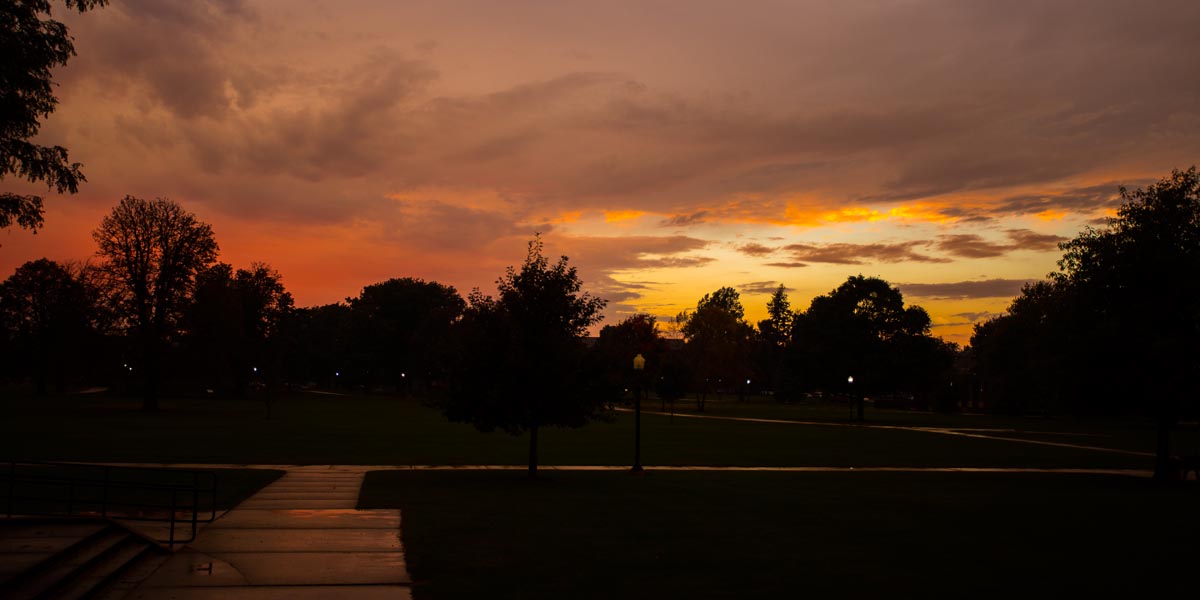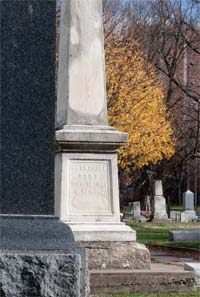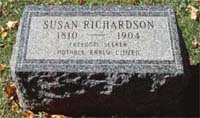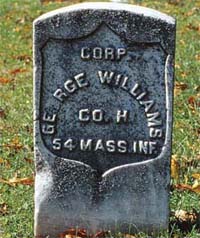

Venture Boldly

The Tie that Binds College & Town
By Tom Wilson
 Like all groups of pioneers making the long and arduous journey across thousands of miles of rough terrain, the families who migrated from New York in pursuit of the Reverend George Washington Gale's dream to form a college and a town suffered illness and loss. Upon arrival on the Illinois prairie, the settlers first built temporary housing and, out of necessity, burial grounds. Originally known simply as "The Burying Ground," this cemetery was established by the trustees of Galesburg's First Church of Christ in 1836, one year prior to the establishment of the city and the College.
Like all groups of pioneers making the long and arduous journey across thousands of miles of rough terrain, the families who migrated from New York in pursuit of the Reverend George Washington Gale's dream to form a college and a town suffered illness and loss. Upon arrival on the Illinois prairie, the settlers first built temporary housing and, out of necessity, burial grounds. Originally known simply as "The Burying Ground," this cemetery was established by the trustees of Galesburg's First Church of Christ in 1836, one year prior to the establishment of the city and the College.
Hope Cemetery, as it eventually became known, has since become the final resting place of the original movers and shakers who helped establish Knox College and Galesburg, as well as College professors and students, soldiers, mayors, store keepers, journalists, and hundreds of others who lived in this prairie town. If there is one place that forever binds Knox College and Galesburg together, Hope Cemetery is it.
Isaac Mills, one of three members of the original founding party, is the first recorded burial in Hope Cemetery, as he died of malaria shortly after arriving in 1836. Galesburg and Knox College's founder, George Washington Gale, and most of his direct family members are also buried in Hope, along with three former Knox College presidents -- Hiram H. Kellogg, who was the first to serve the new and fledging institution from 1841 to 1845; Harvey Curtis, who became the third president from 1858 to 1863 in a time that included the historic Lincoln-Douglas Debate; and Newton Bateman, who served Knox from 1875 to 1892, after serving as the first Illinois State Superintendent of Education.
Others include George Churchill, who was the original principal of the Knox Academy and credited with being the founder of the Galesburg Public School System; Maria H. Whiting, who served as principal of the Knox College Female Seminary and is the namesake of the College's former women's dormitory, Whiting Hall; Henry E. Hitchcock, who was a member of the first Knox graduating class and later a professor at the school; and Janet Grieg Post, member of the Class of 1894, who served as both Knox dean of students and a member of the Board of Trustees and was responsible for the renovation of Old Main in 1937.

Additional individuals with Knox connections buried in Hope Cemetery included Professor Nehemiah H. Losey, who served as Galesburg's first postmaster; Milton Comstock and Albert Hood, who both served for 50-plus years as Knox professors; Albert Perry, a local banker, who served several years as College treasurer; Henry Sanderson, who served as Galesburg's first mayor and hosted Abraham Lincoln overnight at his residence following the famed Lincoln-Douglas Debate. Sanderson's wife, Ann Dunn, was among the first women to receive a degree from the Knox Female Seminary.
Other early prominent citizens buried in Hope are Chauncey Colton, the town's first retail merchant; Susan Richardson, a runaway slave who found freedom in Galesburg and was involved in the operation of the Underground Railroad; Philip Sidney Post Sr., a Civil War general and Medal of Honor recipient; Ernest Elmo Calkins, who authored the popular book about local history entitled They Broke The Prairie; S.S. McClure, a Knox graduate of 1882, who published the famed McClure's Magazine; George Williams, a black Civil War soldier of the famed 54th Massachusetts Volunteer Infantry. Thirteen men who have served as mayor of Galesburg can also be found in Hope.
 As has been the case since its beginnings, Hope Cemetery is privately owned and managed and continues to serve the Galesburg area. Similarly, its history continues to fascinate Galesburg residents and visitors alike, and Hope is often toured during Knox's Homecoming weekend and other community events. As local historian Harry Bulkeley says, Hope Cemetery serves as "Galesburg's outdoor history museum."
As has been the case since its beginnings, Hope Cemetery is privately owned and managed and continues to serve the Galesburg area. Similarly, its history continues to fascinate Galesburg residents and visitors alike, and Hope is often toured during Knox's Homecoming weekend and other community events. As local historian Harry Bulkeley says, Hope Cemetery serves as "Galesburg's outdoor history museum."
Tom Wilson is a historical columnist for Galesburg's The Register-Mail. He has served as a board member of Carl Sandburg Community College, is the former City of Galesburg Treasurer, and is an honorary member of the Knox-Lombard Fifty Year Club.
6
years on the Forbes Grateful Grads Index
where alumni feel they received the greatest return on their college investment